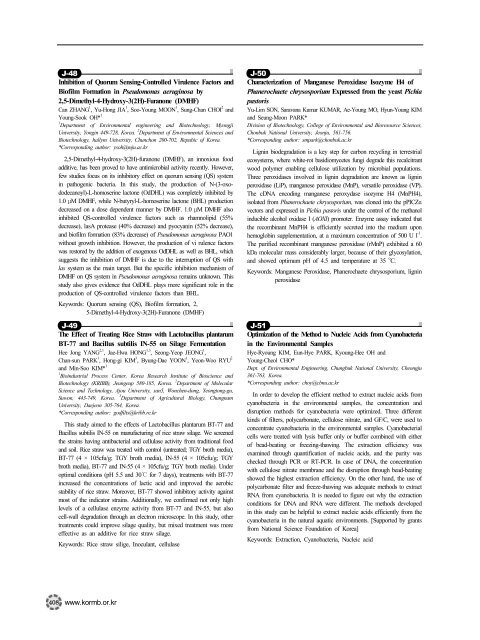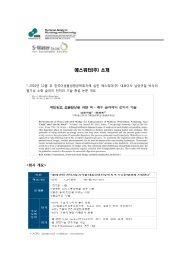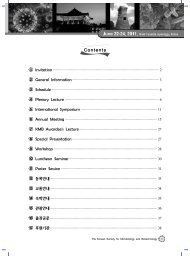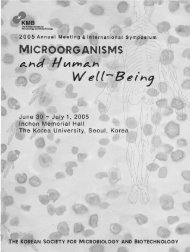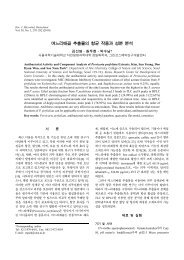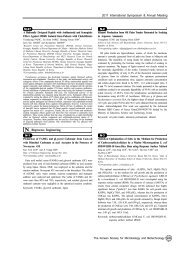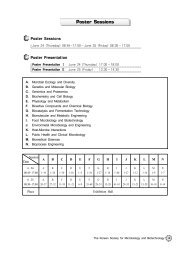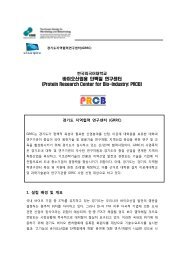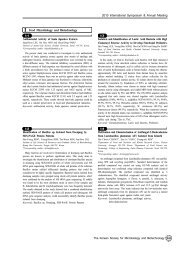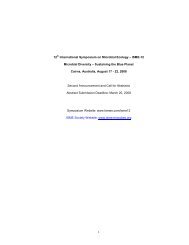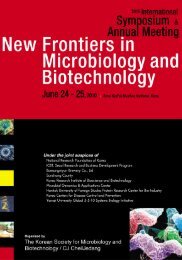J_Environmetal Microbiology and Engineering
J_Environmetal Microbiology and Engineering
J_Environmetal Microbiology and Engineering
You also want an ePaper? Increase the reach of your titles
YUMPU automatically turns print PDFs into web optimized ePapers that Google loves.
Inhibition of Quorum Sensing-Controlled Virulence Factors <strong>and</strong><br />
Biofilm Formation in Pseudomonas aeruginosa by<br />
2,5-Dimethyl-4-Hydroxy-3(2H)-Furanone (DMHF)<br />
Can ZHANG 1 , Yu-Hong JIA 1 , Soo-Young MOON 1 , Sung-Chan CHOI 2 <strong>and</strong><br />
Young-Sook OH* 1<br />
1<br />
Department of Environmental engineering <strong>and</strong> Biotechnology, Myongji<br />
University, Yongin 449-728, Korea. 2 J-48<br />
Department of Environmental Sciences <strong>and</strong><br />
Biotechnology, hallym University, Chunchon 200-702, Repubic of Korea.<br />
*Corresponding author: ysoh@mju.ac.kr<br />
2,5-Dimethyl-4-hydroxy-3(2H)-furanone (DMHF), an innoxious food<br />
additive, has been proved to have antimicrobial activity recently. However,<br />
few studies focus on its inhibitory effect on quorum sensing (QS) system<br />
in pathogenic bacteria. In this study, the production of N-(3-oxododecanoyl)-L-homoserine<br />
lactone (OdDHL) was completely inhibited by<br />
1.0 μM DMHF, while N-butyryl-L-homoserine lactone (BHL) production<br />
decreased on a dose dependent manner by DMHF. 1.0 μM DMHF also<br />
inhibited QS-controlled virulence factors such as rhamnolipid (55%<br />
decrease), lasA protease (40% decrease) <strong>and</strong> pyocyanin (52% decrease),<br />
<strong>and</strong> biofilm formation (83% decrease) of Pseudomonas aeruginosa PAO1<br />
without growth inhibition. However, the production of vi rulence factors<br />
was restored by the addition of exogenous OdDHL as well as BHL, which<br />
suggests the inhibition of DMHF is due to the interruption of QS with<br />
las system as the main target. But the specific inhibition mechanism of<br />
DMHF on QS system in Pseudomonas aeruginosa remains unknown. This<br />
study also gives evidence that OdDHL plays more significant role in the<br />
production of QS-controlled virulence factors than BHL.<br />
Keywords: Quorum sensing (QS), Biofilm formation, 2,<br />
5-Dimethyl-4-Hydroxy-3(2H)-Furanone (DMHF)<br />
The Effect of Treating Rice Straw with Lactobacillus plantarum<br />
BT-77 <strong>and</strong> Bacillus subtilis IN-55 on Silage Fermentation<br />
Hee Jong YANG 2,1 , Jae-Hwa HONG 1,3 , Seong-Yeop JEONG 1 ,<br />
Chan-sun PARK 1 , Hong-gi KIM 3 , Byung-Dae YOON 1 , Yeon-Woo RYU 2<br />
<strong>and</strong> Min-Soo KIM* 1<br />
1<br />
Bioindustrial Process Center, Korea Research Institute of Bioscience <strong>and</strong><br />
Biotechnology (KRIBB), Jeungeup 580-185, Korea. 2 Department of Molecular<br />
Science <strong>and</strong> Technology, Ajou University, san5, Wonchen-dong, Yeongtong-gu,<br />
Suwon, 443-749, Korea. 3 J-49<br />
Department of Agricultural Biology, Chungnam<br />
University, Daejeon 305-764, Korea.<br />
*Corresponding author: godfilts@kribb.re.kr<br />
This study aimed to the effects of Lactobacillus plantarum BT-77 <strong>and</strong><br />
Bacillus subtilis IN-55 on manufacturing of rice straw silage. We screened<br />
the strains having antibacterial <strong>and</strong> cellulase activity from traditional food<br />
<strong>and</strong> soil. Rice straw was treated with control (untreated; TGY broth media),<br />
BT-77 (4 × 105cfu/g; TGY broth media), IN-55 (4 × 105cfu/g; TGY<br />
broth media), BT-77 <strong>and</strong> IN-55 (4 × 105cfu/g; TGY broth media). Under<br />
optimal conditions (pH 5.5 <strong>and</strong> 30℃ for 7 days), treatments with BT-77<br />
increased the concentrations of lactic acid <strong>and</strong> improved the aerobic<br />
stability of rice straw. Moreover, BT-77 showed inhibitory activity against<br />
most of the indicator strains. Additionally, we confirmed not only high<br />
levels of a cellulase enzyme activity from BT-77 <strong>and</strong> IN-55, but also<br />
cell-wall degradation through an electron microscope. In this study, other<br />
treatments could improve silage quality, but mixed treatment was more<br />
effective as an additive for rice straw silage.<br />
Keywords: Rice straw silige, Inoculant, cellulase<br />
408 www.kormb.or.kr<br />
J-50<br />
Characterization of Manganese Peroxidase Isozyme H4 of<br />
Phanerochaete chrysosporium Expressed from the yeast Pichia<br />
pastoris<br />
Yu-Lim SON, Saravana Kumar KUMAR, Ae-Young MO, Hyun-Young KIM<br />
<strong>and</strong> Seung-Moon PARK*<br />
Division of Biotechnology, College of Environmental <strong>and</strong> Bioresource Sciences,<br />
Chonbuk National University, Jeonju, 561-756.<br />
*Corresponding author: smpark@chonbuk.ac.kr<br />
Lignin biodegradation is a key step for carbon recycling in terrestrial<br />
ecosystems, where white-rot basidiomycetes fungi degrade this recalcitrant<br />
wood polymer enabling cellulose utilization by microbial populations.<br />
Three peroxidases involved in lignin degradation are known as lignin<br />
peroxidase (LiP), manganese peroxidase (MnP), versatile peroxidase (VP).<br />
The cDNA encoding manganese peroxydase isozyme H4 (MnPH4),<br />
isolated from Phanerochaete chrysosporium, was cloned into the pPICZα<br />
vectors <strong>and</strong> expressed in Pichia pastoris under the control of the methanol<br />
inducible alcohol oxidase I (AOXI) promoter. Enzyme assay indicated that<br />
the recombinant MnPH4 is efficiently secreted into the medium upon<br />
hemoglobin supplementation, at a maximum concentration of 500 U l -1 .<br />
The purified recombinant manganese peroxidase (rMnP) exhibited a 60<br />
kDa molecular mass considerably larger, because of their glycosylation,<br />
<strong>and</strong> showed optimum pH of 4.5 <strong>and</strong> temperature at 35 o C.<br />
Keywords: Manganese Peroxidase, Phanerochaete chrysosporium, lignin<br />
peroxidase<br />
J-51<br />
Optimization of the Method to Nucleic Acids from Cyanobacteria<br />
in the Environmental Samples<br />
Hye-Ryoung KIM, Eun-Hye PARK, Kyoung-Hee OH <strong>and</strong><br />
Young-Cheol CHO*<br />
Dept. of Environmental <strong>Engineering</strong>, Chungbuk National University, Cheongju<br />
361-763, Korea.<br />
*Corresponding author: choy@cbnu.ac.kr<br />
In order to develop the efficient method to extract nucleic acids from<br />
cyanobacteria in the environmental samples, the concentration <strong>and</strong><br />
disruption methods for cyanobacteria were optimized. Three different<br />
kinds of filters, polycarbonate, cellulose nitrate, <strong>and</strong> GF/C, were used to<br />
concentrate cyanobacteria in the environmental samples. Cyanobacterial<br />
cells were treated with lysis buffer only or buffer combined with either<br />
of bead-beating or freezing-thawing. The extraction efficiency was<br />
examined through quantification of nucleic acids, <strong>and</strong> the purity was<br />
checked through PCR or RT-PCR. In case of DNA, the concentration<br />
with cellulose nitrate membrane <strong>and</strong> the disruption through bead-beating<br />
showed the highest extraction efficiency. On the other h<strong>and</strong>, the use of<br />
polycarbonate filter <strong>and</strong> freeze-thawing was adequate methods to extract<br />
RNA from cyanobacteria. It is needed to figure out why the extraction<br />
conditions for DNA <strong>and</strong> RNA were different. The methods developed<br />
in this study can be helpful to extract nucleic acids efficiently from the<br />
cyanobacteria in the natural aquatic environments. [Supported by grants<br />
from National Science Foundation of Korea]<br />
Keywords: Extraction, Cyanobacteria, Nucleic acid


